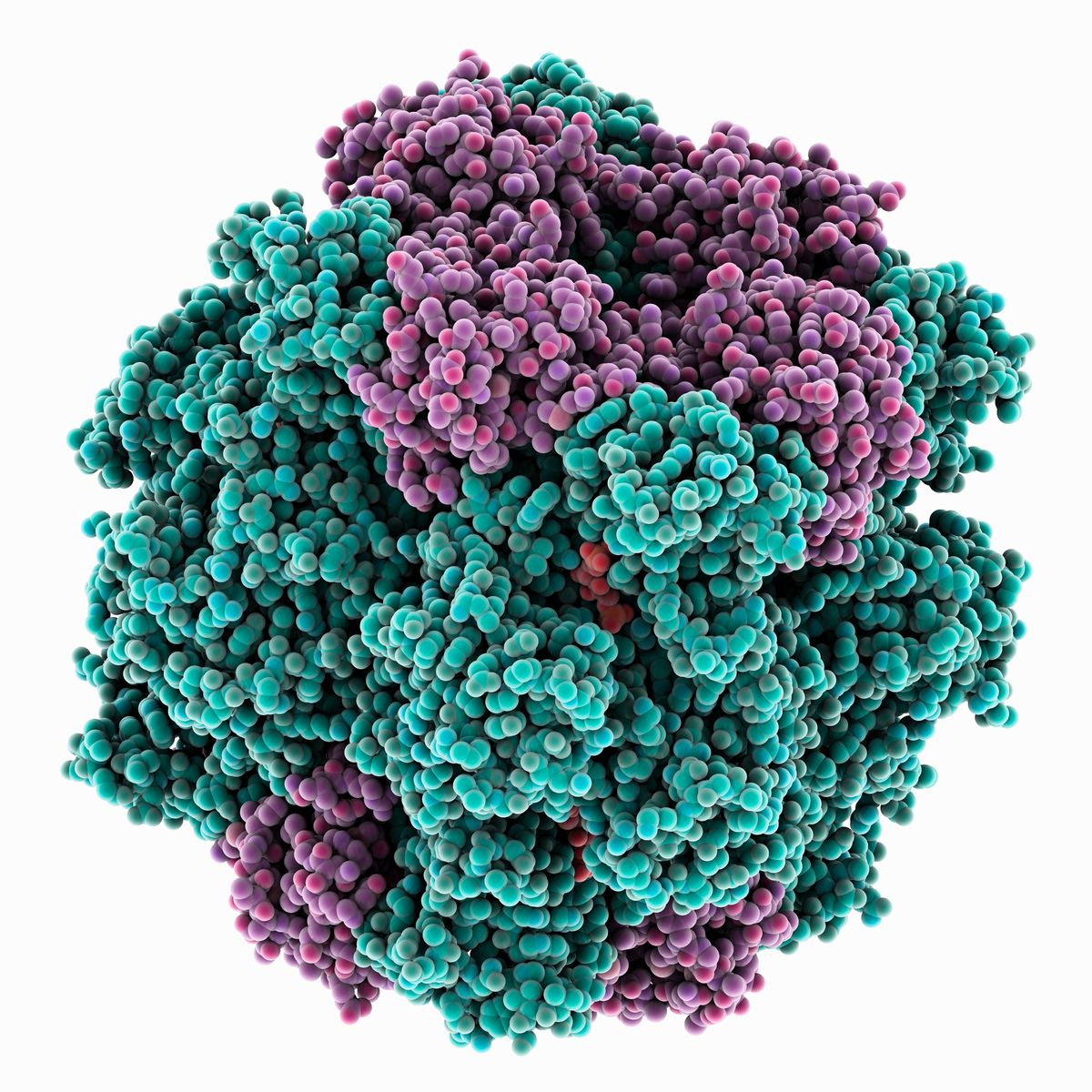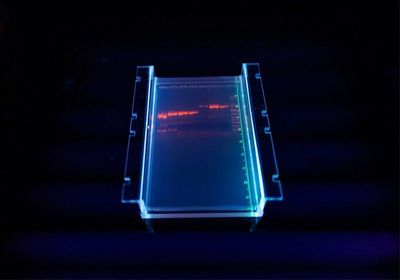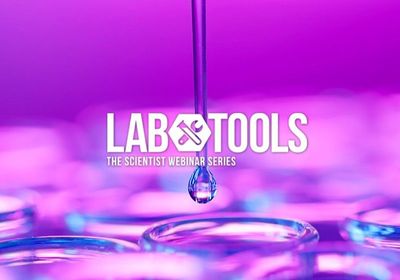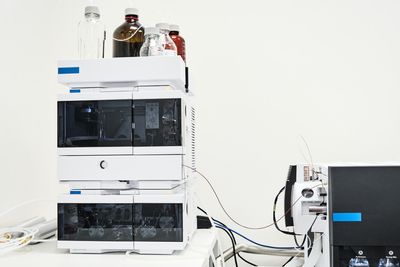ABOVE: © ISTOCK.COM, blew_i
Likely the most abundant enzyme on Earth, Rubisco performs the vital function of fixing carbon from the environment in photosynthetic organisms. Of the four forms of Rubisco known to exist today, form I—present in cyanobacteria, some algae, and plants—has the highest specificity for carbon dioxide and the most efficient catalytic activity. Researchers reconstructed ancestral Rubisco sequences and measured how well these revived putative proteins performed in a lab setting, proposing in a study published online yesterday (October 13) in Science that form I’s improved qualities were acquired thanks to the gain of a small subunit. In the study, the authors retrace how this transition could have taken place.
Form I Rubisco is made up of eight identical catalytic large subunits and eight identical small subunits. Researchers long suspected that its enhanced ability to discriminate CO2 from the chemically similar molecule oxygen (O2) could be related to the presence of these small subunits, since no other forms of Rubisco have them. However, “before this paper came along, we actually had no direct way of validating this,” says University of Oxford plant evolutionary biologist Jacques Bouvier, who did not participate in this study, because removing the small subunits impairs the enzyme’s stability and function.
Bringing extinct Rubiscos back to life
When Georg Hochberg, an evolutionary biochemist at the Max Planck Institute for Terrestrial Microbiology in Marburg, Germany, met synthetic biologist Tobias Erb and doctoral researcher Luca Schulz at the same institute, they thought they could probably tackle together the challenge of testing the role of the small subunit in the enzyme’s performance, he says, using phylogenetics and synthetic biology to reconstruct the ancestors of today’s form I Rubiscos.
The researchers first reconstructed the phylogenies of both the large and small subunits. For this, they “sampled very broadly,” says Schulz, putting together a wide range of sequences obtained from public databases. Their analysis pointed toward two putative key ancestors of the large subunit: AncL, the last common ancestor before the large subunit began interacting with the small subunit, and AncLS, the last common ancestor of all Rubisco in which a large and small subunit interact. The analysis further suggested that the most parsimonious scenario is that form I Rubiscos evolved in thermophilic anaerobes before atmospheric oxygen levels rose, hinting that the high CO2 specificity may not have been a consequence of selective pressure posed by global high O2 levels.
Then, the team synthesized these two large subunit ancestors, as well as an ancestral small subunit (AncSSU) also inferred from the phylogenies. “Once you know that sequence, you can use essentially pretty standard synthetic biology to synthesize a stretch of DNA that codes for it, feed it to bacteria that then interpret the stretch of DNA, and produce the protein,” says Hochberg. The protein is then purified out of these bacteria, and researchers are able to characterize its activity, he explains. From this, he and his colleagues learned, for instance, that AncL does not seem to bind to AncSSU, whereas AncLS does, and furthermore, the small subunit is essential to it—in its absence, AncLS solubility is impaired, suggesting that dependence on the small subunit likely evolved shortly after the interaction did.
See “Scientists Bring Ancient Proteins Back to Life”
Moreover, the catalytic efficiency and specificity to carbon dioxide were higher for the AncLS+AncSSU complex compared to the AncL. Was this due to the presence of the small subunit? It was difficult to tell, since AncLS’s function is impaired without it. Hochberg, Schulz, Erb, and their colleagues thus aimed to reconstruct an ancestor of the large subunit that would allow them to test the question.

AncL and AncLS differed by 95 amino acid substitutions and three insertions. So the team reasoned that, as AncL does not interact with the small subunit and AncLS is dependent on it, those differences may be involved in that association. The researchers focused on 14 differences in AncLS that are near the small subunit. By playing around with these, they came to a Rubisco variant that is soluble and functional without the small subunit but that can bind to it: AncL+7. This enabled them to directly test how the interaction with the small subunit affects Rubisco’s properties: They found that it increased the carboxylation efficiency, the temperature tolerance of catalysis, and the CO2 versus O2 specificity.
That the authors were able to engineer a Rubisco ancestor that was not dependent on the small subunit, yet was able to bind it, is a crucial advance of this paper, says Bouvier. This allowed the researchers “to assess its activity with and without this small subunit, which we can’t do in any other way,” he notes.
The team was also able to show that by introducing one more substitution to AncL+7, specificity was further increased to a level that almost doubles that of AncL. This boost, though, only occurs if the small subunit is present. For Erb, this is “the most exciting finding” of the study—that is, that two Rubisco molecules that differ by a few mutations may behave similarly without the small subunit, but they suddenly diverge in their performance when interacting with it. In a way, he adds, the small subunit acts as an “evolutionary modulator,” meaning that mutations that were silent before suddenly make a difference when this interaction occurs.
Learning about—and from—evolution
Rubisco is known to have evolved prior to the Great Oxidation Event, which took place approximately 2.4 billion years ago when atmospheric oxygen increased, possibly as a consequence of photosynthesis carried out by ancestral cyanobacteria. Yet the timing of the origin of the high-specificity form I Rubisco is unclear. The authors’ proposal that the interaction with and dependence on the small subunit—and consequent properties—may predate the global increase in oxygen on the planet opens an interesting discussion, according to other researchers who spoke with The Scientist.
See “Longer Days Led to Oxygen Buildup on Early Earth: Study”
If this hypothesis is correct, the initial main driving force may have not been avoiding the oxygenation reaction via its high specificity for carbon dioxide, as oxygen was not yet present in the atmosphere at high enough levels to present a problem, says Inger Andersson, a structural biologist at Uppsala University in Sweden and the Institute of Biotechnology of the Czech Academy of Sciences who was not involved in the study. There was likely some other driver—for example, making “a rigid active site that can hold this molecule [CO2] and avoid side reactions,” she says. “Selectivity for the carboxylation over the oxygenation later came as a bonus,” she adds in a follow-up email.
“We know that the global oxygen concentration was low” before the Great Oxidation Event, but “we don’t really have any idea about what the local oxygen concentration might have been in some . . . environments,” says Steven Kelly, a plant scientist studying the evolution of photosynthesis at the University of Oxford. It is possible to speculate that these high-specificity Rubiscos might have evolved in environments with high local oxygen concentrations, he adds, although there is no evidence to suggest whether this was the case. Kelly, who was not involved in the new study, cofounded and consults for Wild Bioscience, a company that aims to improve crop yield by boosting photosynthesis.
Hochberg says that one of the most exciting aspects of this work is that exploring the evolution of a well-studied and famous enzyme “has actually taught us really novel things about how it works. . . . Questions that were not answerable through decades of really hard biochemistry” have now become accessible by integrating this evolutionary perspective.








